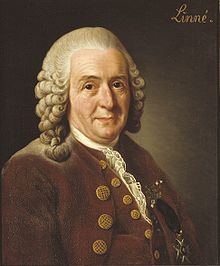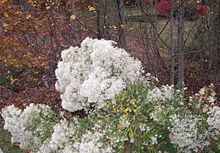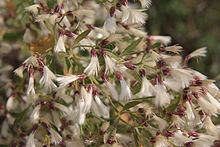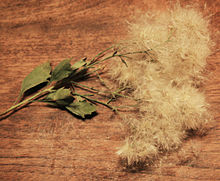- Baccharis halimifolia
-
Baccharis halimifolia is a fall-flowering deciduous or evergreen shrub commonly found in wetlands on the Atlantic and Gulf coastal plains of the eastern United States from Texas and Florida northward to Massachusetts,[1] inland to the District of Columbia[2] and Pennsylvania.[3] The species is also occurs in Mexico,[where?][1] the West Indies,[where?][1] and southernmost Nova Scotia in Canada.[4]
Widely used common names include Eastern Baccharis, Groundsel Bush, Sea Myrtle, and Saltbush, with Consumption Weed, Cotton-seed Tree, Groundsel Tree, Menguilié, and Silverling also used more locally. In most of its range, where no other species of the genus occur, this plant is often simply called Baccharis.
Contents
Classification
Baccharis halimifola was first described and named by Carl Linnaeus in his Species Plantarum, published in 1753. No subspecies or varieties are recognized within the species.
This species is the northernmost member of the large Western Hemisphere genus Baccharis in the aster family (Asteraceae).
Senecio arborescens, a Neotropical species, was confused with Baccharis halimifolia in the past.[citation needed]
Description
 Carl Linnaeus, who first named and described Baccharis halimifolia (1775 portrait by Alexander Roslin)
Carl Linnaeus, who first named and described Baccharis halimifolia (1775 portrait by Alexander Roslin)
Baccharis halimifolia is a shrub growing to about 12 ft (4 m) high and comparably wide, or occasionally a small tree. Its simple, alternate, thick, egg-shaped to rhombic leaves mostly have coarse teeth, with the uppermost leaves entire. These fall-flowering Baccharis plants are dioecious, with male and female flowers on separate individuals. Their flowers are borne in numerous small, compact heads in large leafy terminal inflorescences, with the snowy-white, cotton-like female flower-heads showy and conspicuous at a distance.[5][6]
The species is sometimes confused with the marsh-elder (Iva frutescens),[7] with which it often co-occurs, but the Baccharis has its leaves alternate, while those of the Iva are alternate.[5]
Ecology
Baccharis halimifolia, usually found in wetlands, is unusually salt-tolerant, and often found along salty or brackish shores of marshes and estuaries, and the inland shores of coastal barrier islands. In Florida, it is also found along ditches, in old fields, and in other disturbed areas.[6] Other habitats in the northeastern United States include freshwater tidal marshes and open woods and thickets along the seacoast.[5]
The flowers produce abundant nectar that attracts various butterflies, including the Monarch (Danaus plexippus).[6] These dense shrubs also provide wildlife food and cover.[6]
Invasiveness
In Australia, B. halimifolia is an invasive species along the coast of southern Queensland and New South Wales.[1] The species has also become naturalized in Europe[6] and in New Zealand.[6]
In the northeastern United States, the species has become common well inland of the shrub's natural range along various major highways where road salt is heavily used,[3] sometimes forming conspicuous displays when flowering in the fall, as along I-95 in Howard County, Maryland.
Toxicity
The seeds of Baccharis halimifolia are toxic to humans.[6]
Uses
Baccharis halimifolia is occasionally cultivated, useful as a hedge or border as well as a specimen plant.[6]
In Louisiana, there is a folk knowledge[by whom?] of medicinal use for B. halimifolia, where it is also known as menglier (menguilié). The leaves of this plant are boiled into an aromatic green brew and served hot to treat fever, congestion, and other cold or pneumonia-type symptoms, sometimes with lemon, honey, or sugar, or with a mint or cough drop (for flavor), and/or with whiskey.[citation needed]
References
- ^ a b c d "Baccharis halimifolia". Flora of North America. http://www.efloras.org/florataxon.aspx?flora_id=1&taxon_id=250066181. Retrieved 11 October 2011.
- ^ Hitchcock, A.S., and P. C. Standley (1919). Flora of the District of Columbia and Vicinity (Contributions from the United States National Herbarium, vol.21). Washington: United States National Museum (Reprinted by Kessinger Publishing, LaVergne, Tennessee, 2010). pp. 329 (+42 plates). ISBN 1436985587.
- ^ a b "Eastern Baccharis (Baccharis halimifolia))". Pennsylvania Rare Plant Species. Pennsylvania Natural Heritage Program. http://www.gis.dcnr.state.pa.us/hgis/factsheets/Eastern%20Baccharis.pdf. Retrieved 11 October 2011.
- ^ "Species at Risk Conservation Fund 2009 Approved Projects:". Nova Scotia Canada Department of Natural Resources. http://gov.ns.ca/natr/wildlife/conservationfund/2009projects.asp. Retrieved 11 October 2011.
- ^ a b c Tiner, Ralph W., Jr. (1987). A Field Guide to Coastal Wetland Plants of the Northeastern United States. Amherst [Massachusetts]: University of Massachusetts Press. pp. [iii] + 285. ISBN 0-87023-538-9.
- ^ a b c d e f g h Brown, Steven H., and Kim Cooperrider. "Baccharis halimifolia". University of Florida Institute of Food and Agricultural Services. http://lee.ifas.ufl.edu/Hort/GardenPubsAZ/Saltbush_Baccharis_halimifolia.pdf. Retrieved 12 October 2011.
- ^ "Iva frutescens". Flora of North America. Flora of North America. http://www.efloras.org/florataxon.aspx?flora_id=1&taxon_id=250067019. Retrieved 12 October 2011.
Other references
- Blanchan, Neltje (2002). Wild Flowers: An Aid to Knowledge of our Wild Flowers and their Insect Visitors. Project Gutenberg Literary Archive Foundation.
- Niering, William, Olmstead, Nancy, National Audubon Society Field Guide to North American Wildflowers Eastern Region, 1995,ISBN 0-394-50423-1, p. 367
External links
 Media related to Baccharis halimifolia at Wikimedia Commons
Media related to Baccharis halimifolia at Wikimedia Commons Data related to Baccharis halimifolia at Wikispecies
Data related to Baccharis halimifolia at Wikispecies- Duke University
- Astereae stubs
- Baccharis
- Plants described in 1753
- Flora of the Eastern United States
- Flora of Alabama
Wikimedia Foundation. 2010.



